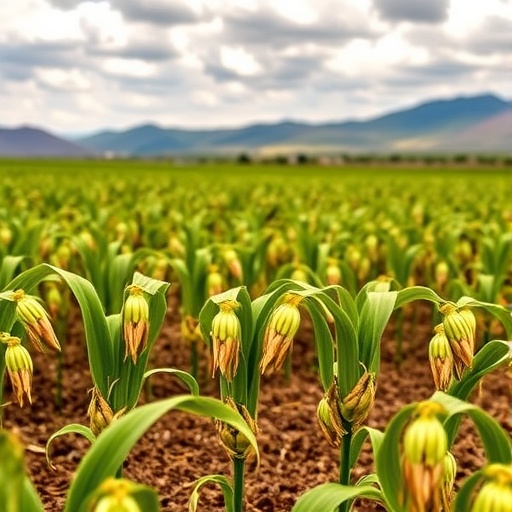What does climate change mean for agriculture? Less food, and more emissions – Grist.org

Impact of Climate Change on Global Agricultural Production and Food Security
Introduction
Recent research highlights the critical challenge of sustaining food production amid global warming. Two studies—one historical and one predictive—investigate how rising temperatures reduce agricultural efficiency, reshaping the global food system as producers adapt to hotter growing seasons. These findings emphasize the complex relationship between agriculture and climate change, directly relating to the United Nations Sustainable Development Goals (SDGs), particularly SDG 2 (Zero Hunger), SDG 13 (Climate Action), and SDG 12 (Responsible Consumption and Production).
Challenges in Agricultural Production and Climate Change
- Agriculture contributes significantly to climate change, accounting for approximately 25% to 33% of global greenhouse gas emissions.
- Climate change negatively impacts agricultural productivity through droughts, heat waves, and extreme weather events, leading to reduced crop yields and increased food prices.
- Farmers face the dual challenge of mitigating their environmental impact while adapting to changing climatic conditions.
Forward-Looking Study on Caloric Output Decline
A study published in Nature (June 18) by researchers from the University of Illinois Urbana-Champaign and Stanford Doerr School of Sustainability analyzed the effect of warming temperatures on the caloric output of six staple crops across over 12,000 regions in 54 countries.
- Findings indicate that for every 1°C increase above the 2000-2010 average, the global food system produces approximately 120 fewer calories per person per day.
- Under a 3°C warming scenario by 2100, this reduction equates to the loss of a global breakfast meal per person daily.
- Adaptation strategies by farmers, such as planting fast-maturing crop varieties, mitigate some losses but often come with trade-offs, including lower overall yields.
Regional and Socioeconomic Impacts
- Crop yield losses will vary regionally; for example, U.S. corn farmers may experience 40-50% yield reductions, threatening traditional agricultural zones like the Corn Belt.
- Conversely, rice yields in South and Southeast Asia may increase, illustrating regional disparities.
- Food price increases will disproportionately affect poorer countries, exacerbating food insecurity and undermining SDG 2.
Historical Study on Land Clearing and Emissions
Published in Nature Geosciences (June 20), this study examines how agricultural expansion through land clearing contributes to greenhouse gas emissions, particularly in carbon-rich tropical regions.
- Between 1992 and 2020, climate change drove the expansion of cropland by 88 million hectares (approximately twice the size of California), despite technological improvements in productivity.
- Major agricultural producers such as the United States, India, China, Russia, and Brazil led this expansion and are also the highest emitters of related greenhouse gases.
- This feedback loop—where climate change reduces crop efficiency, prompting land clearing that further exacerbates emissions—poses significant challenges to achieving SDG 13.
Implications for Global Trade and Adaptation
- Shifts in agricultural productivity will alter global trade dynamics, with some regions gaining competitive advantages while others face losses.
- Experts emphasize the necessity of large-scale innovation and adaptation, including potential advances in genetic editing and crop diversification.
- Farmer behavior is expected to evolve, with shifts toward crops better suited to changing climates, potentially reducing the need for further land clearing.
Recommendations for Sustainable Agricultural Development
- Enhance collaboration between climate researchers, institutions, and farmers to develop bottom-up adaptation strategies aligned with local conditions and knowledge.
- Promote innovation in agricultural technologies to improve crop resilience and productivity under climate stress.
- Implement policies that balance agricultural expansion with conservation to mitigate deforestation and emissions.
- Address food security disparities by supporting vulnerable populations in poorer countries to adapt to rising food prices and supply challenges.
Conclusion
The studies underscore the urgent need to integrate climate action with sustainable agricultural practices to meet the SDGs, particularly SDG 2 (Zero Hunger) and SDG 13 (Climate Action). Addressing the intertwined challenges of climate change and food production requires coordinated efforts across scientific, policy, and farming communities to ensure global food security in a warming world.
1. Sustainable Development Goals (SDGs) Addressed or Connected
- SDG 2: Zero Hunger – The article discusses challenges in agricultural production due to climate change, impacting food availability and prices, which directly relates to ending hunger and achieving food security.
- SDG 13: Climate Action – The article highlights how agriculture contributes to greenhouse gas emissions and how climate change affects agricultural productivity, emphasizing the need for urgent climate action.
- SDG 15: Life on Land – The article addresses land clearing and deforestation for cropland expansion, impacting terrestrial ecosystems and biodiversity.
- SDG 12: Responsible Consumption and Production – Implied through discussions on agricultural adaptation, efficiency, and sustainable land use.
2. Specific Targets Under Those SDGs Identified
- SDG 2: Zero Hunger
- Target 2.3: By 2030, double the agricultural productivity and incomes of small-scale food producers.
- Target 2.4: Ensure sustainable food production systems and implement resilient agricultural practices.
- SDG 13: Climate Action
- Target 13.1: Strengthen resilience and adaptive capacity to climate-related hazards and natural disasters in all countries.
- Target 13.2: Integrate climate change measures into national policies, strategies, and planning.
- SDG 15: Life on Land
- Target 15.2: Promote the implementation of sustainable management of all types of forests, halt deforestation, restore degraded forests.
- Target 15.3: Combat desertification, restore degraded land and soil.
- SDG 12: Responsible Consumption and Production
- Target 12.2: Achieve the sustainable management and efficient use of natural resources.
3. Indicators Mentioned or Implied to Measure Progress
- Caloric output per person per day – The forward-looking study quantifies the decline in calories produced per person per day with each degree Celsius of warming, which can measure food availability and nutritional sufficiency (related to SDG 2).
- Crop yield changes – Percentage losses or gains in crop yields (e.g., 40-50% loss for U.S. corn farmers) serve as indicators of agricultural productivity and adaptation effectiveness (SDG 2, SDG 13).
- Extent of cropland expansion (hectares) – The historical study measures cropland expansion due to climate change (88 million hectares between 1992 and 2020), indicating land use change and deforestation rates (SDG 15).
- Greenhouse gas emissions from agriculture – Emissions linked to agricultural production and land clearing are implied indicators for climate impact assessment (SDG 13).
- Food price changes – Mentioned as an economic indicator reflecting food security and market impacts (SDG 2).
4. Table: SDGs, Targets and Indicators
| SDGs | Targets | Indicators |
|---|---|---|
| SDG 2: Zero Hunger |
|
|
| SDG 13: Climate Action |
|
|
| SDG 15: Life on Land |
|
|
| SDG 12: Responsible Consumption and Production |
|
|
Source: grist.org

What is Your Reaction?
 Like
0
Like
0
 Dislike
0
Dislike
0
 Love
0
Love
0
 Funny
0
Funny
0
 Angry
0
Angry
0
 Sad
0
Sad
0
 Wow
0
Wow
0















































































